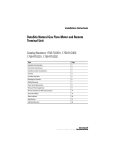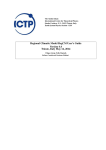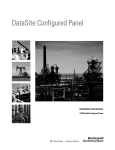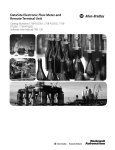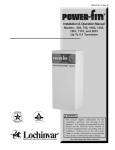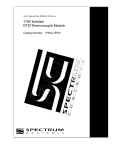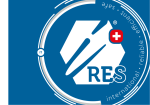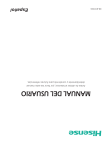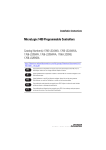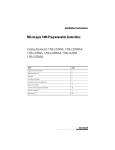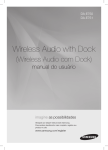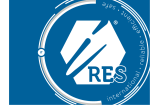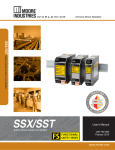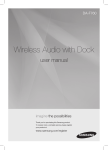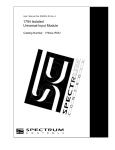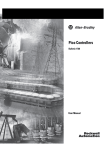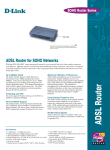Download 1758-UM001 - Rockwell Automation
Transcript
DataSite Electronic Flow Meter and Remote Terminal Unit Catalog Numbers 1758-FLO301, 1758-FLO302, 1758RTU201, 1758-RTU202 Hardware User Manual Important User Information Solid state equipment has operational characteristics differing from those of electromechanical equipment. Safety Guidelines for the Application, Installation and Maintenance of Solid State Controls (publication SGI-1.1 available from your local Rockwell Automation sales office or online at http://literature.rockwellautomation.com) describes some important differences between solid state equipment and hard-wired electromechanical devices. Because of this difference, and also because of the wide variety of uses for solid state equipment, all persons responsible for applying this equipment must satisfy themselves that each intended application of this equipment is acceptable. In no event will Rockwell Automation, Inc. be responsible or liable for indirect or consequential damages resulting from the use or application of this equipment. The examples and diagrams in this manual are included solely for illustrative purposes. Because of the many variables and requirements associated with any particular installation, Rockwell Automation, Inc. cannot assume responsibility or liability for actual use based on the examples and diagrams. No patent liability is assumed by Rockwell Automation, Inc. with respect to use of information, circuits, equipment, or software described in this manual. Reproduction of the contents of this manual, in whole or in part, without written permission of Rockwell Automation, Inc., is prohibited. Throughout this manual, when necessary, we use notes to make you aware of safety considerations. WARNING Identifies information about practices or circumstances that can cause an explosion in a hazardous environment, which may lead to personal injury or death, property damage, or economic loss. IMPORTANT Identifies information that is critical for successful application and understanding of the product. ATTENTION Identifies information about practices or circumstances that can lead to: personal injury or death, property damage, or economic loss. Attentions help you identify a hazard, avoid a hazard, and recognize the consequence. SHOCK HAZARD Labels may be on or inside the equipment, such as a drive or motor, to alert people that dangerous voltage may be present. BURN HAZARD Labels may be on or inside the equipment, such as a drive or motor, to alert people that surfaces may reach dangerous temperatures. Allen-Bradley, Datasite, Rockwell Automation, and TechConnect are trademarks of Rockwell Automation, Inc. Trademarks not belonging to Rockwell Automation are property of their respective companies. Table of Contents Table of Contents Preface Who Should Use this Manual . . . . . . . . . . . . . . . . . . . . . . . . . . . . . . . . . 5 Purpose of this Manual . . . . . . . . . . . . . . . . . . . . . . . . . . . . . . . . . . . . . . 5 Related Documentation . . . . . . . . . . . . . . . . . . . . . . . . . . . . . . . . . . . . . . 5 Common Techniques Used in this Manual. . . . . . . . . . . . . . . . . . . . . . . 6 Chapter 1 Overview Introduction . . . . . . . . . . . . . . . . . . . . . . . . . . . . . . . . . . . . . . . . . . . . . . . 7 1758-FLO DataSite controllers . . . . . . . . . . . . . . . . . . . . . . . . . . . . . 8 Features at a Glance. . . . . . . . . . . . . . . . . . . . . . . . . . . . . . . . . . . . . . 8 Controller Description . . . . . . . . . . . . . . . . . . . . . . . . . . . . . . . . . . . . . . . 9 Chapter 2 Installing the Controller Agency Certifications . . . . . . . . . . . . . . . . . . . . . . . . . . . . . . . . . . . . . . . 11 Compliance to European Union Directives . . . . . . . . . . . . . . . . . . . . . 11 EMC Directive. . . . . . . . . . . . . . . . . . . . . . . . . . . . . . . . . . . . . . . . . 11 Installation Considerations . . . . . . . . . . . . . . . . . . . . . . . . . . . . . . . . . . 11 Safety Considerations. . . . . . . . . . . . . . . . . . . . . . . . . . . . . . . . . . . . . . . 12 Hazardous Location Considerations. . . . . . . . . . . . . . . . . . . . . . . . 12 Environnements dangereux. . . . . . . . . . . . . . . . . . . . . . . . . . . . . . . 13 Disconnecting Main Power . . . . . . . . . . . . . . . . . . . . . . . . . . . . . . . 14 Safety Circuits. . . . . . . . . . . . . . . . . . . . . . . . . . . . . . . . . . . . . . . . . . 14 Power Distribution . . . . . . . . . . . . . . . . . . . . . . . . . . . . . . . . . . . . . 15 Periodic Tests of Master Control Relay Circuit . . . . . . . . . . . . . . . 15 Power Considerations . . . . . . . . . . . . . . . . . . . . . . . . . . . . . . . . . . . . . . 15 Loss of Power Source . . . . . . . . . . . . . . . . . . . . . . . . . . . . . . . . . . . 15 Input States on Power Down . . . . . . . . . . . . . . . . . . . . . . . . . . . . . 16 Other Types of Line Conditions . . . . . . . . . . . . . . . . . . . . . . . . . . . 16 Preventing Excessive Heat. . . . . . . . . . . . . . . . . . . . . . . . . . . . . . . . . . . 16 Master Control Relay . . . . . . . . . . . . . . . . . . . . . . . . . . . . . . . . . . . . . . . 17 Using Emergency-Stop Switches . . . . . . . . . . . . . . . . . . . . . . . . . . 18 Using the Lithium Battery . . . . . . . . . . . . . . . . . . . . . . . . . . . . . . . . . . . 18 Controller Mounting Dimensions . . . . . . . . . . . . . . . . . . . . . . . . . . . . . 19 Controller Spacing . . . . . . . . . . . . . . . . . . . . . . . . . . . . . . . . . . . . . . . . . 19 Mounting the Controller . . . . . . . . . . . . . . . . . . . . . . . . . . . . . . . . . . . . 20 DIN Rail Mounting . . . . . . . . . . . . . . . . . . . . . . . . . . . . . . . . . . . . . 20 Chapter 3 Wiring the Controller 3 Connectors on the DataSite Controller. . . . . . . . . . . . . . . . . . . . . . . . . 23 Wiring Requirements . . . . . . . . . . . . . . . . . . . . . . . . . . . . . . . . . . . . . . . 24 Wiring Recommendation . . . . . . . . . . . . . . . . . . . . . . . . . . . . . . . . 24 Wiring the Terminal Block . . . . . . . . . . . . . . . . . . . . . . . . . . . . . . . 25 Using Surge Suppressors . . . . . . . . . . . . . . . . . . . . . . . . . . . . . . . . . . . . 26 Recommended Surge Suppressors . . . . . . . . . . . . . . . . . . . . . . . . . 28 Power Source Requirements . . . . . . . . . . . . . . . . . . . . . . . . . . . . . . . . . 28 Grounding the Controller . . . . . . . . . . . . . . . . . . . . . . . . . . . . . . . . . . . 29 Publication 1758-UM001D-EN-P - June 2011 4 Table of Contents Power Wiring . . . . . . . . . . . . . . . . . . . . . . . . . . . . . . . . . . . . . . . . . . . . . 29 I/O Wiring . . . . . . . . . . . . . . . . . . . . . . . . . . . . . . . . . . . . . . . . . . . . . . . 30 Minimizing Electrical Noise . . . . . . . . . . . . . . . . . . . . . . . . . . . . . . 30 Wiring for Analog Input (AI) . . . . . . . . . . . . . . . . . . . . . . . . . . . . . 31 Wiring for Analog Output (AO) . . . . . . . . . . . . . . . . . . . . . . . . . . . 31 Minimizing Electrical Noise on Analog Channels . . . . . . . . . . . . . 32 Grounding Your Analog Cable . . . . . . . . . . . . . . . . . . . . . . . . . . . . 32 Wiring for Digital Input (DI) . . . . . . . . . . . . . . . . . . . . . . . . . . . . . 33 Wiring for Digital Output (DO) . . . . . . . . . . . . . . . . . . . . . . . . . . . 34 Wiring for Pulse Count Input (PI) . . . . . . . . . . . . . . . . . . . . . . . . . 35 Wiring for RS232 Serial Communications . . . . . . . . . . . . . . . . . . . 35 Wiring for RS485 Serial Communications . . . . . . . . . . . . . . . . . . . 39 Wiring for HART Communication. . . . . . . . . . . . . . . . . . . . . . . . . 41 Wiring for Ethernet Communication . . . . . . . . . . . . . . . . . . . . . . . 42 Wiring for Wake Up mode . . . . . . . . . . . . . . . . . . . . . . . . . . . . . . . 45 Chapter 4 Operating the Controller Operating Modes . . . . . . . . . . . . . . . . . . . . . . . . . . . . . . . . . . . . . . . . . . 47 Run Mode. . . . . . . . . . . . . . . . . . . . . . . . . . . . . . . . . . . . . . . . . . . . . 47 Service Mode . . . . . . . . . . . . . . . . . . . . . . . . . . . . . . . . . . . . . . . . . . 47 Sleep Mode. . . . . . . . . . . . . . . . . . . . . . . . . . . . . . . . . . . . . . . . . . . . 48 LED Indicators . . . . . . . . . . . . . . . . . . . . . . . . . . . . . . . . . . . . . . . . . . . 48 Power Control . . . . . . . . . . . . . . . . . . . . . . . . . . . . . . . . . . . . . . . . . . . . 49 LED Power Control . . . . . . . . . . . . . . . . . . . . . . . . . . . . . . . . . . . . 49 COM1 Power Control . . . . . . . . . . . . . . . . . . . . . . . . . . . . . . . . . . . 49 Ethernet Power Control . . . . . . . . . . . . . . . . . . . . . . . . . . . . . . . . . 50 Counter Input Filters . . . . . . . . . . . . . . . . . . . . . . . . . . . . . . . . . . . . . . . 50 Real-Time Clock. . . . . . . . . . . . . . . . . . . . . . . . . . . . . . . . . . . . . . . . . . . 51 Modbus Register Assignment . . . . . . . . . . . . . . . . . . . . . . . . . . . . . . . . 51 Assigned Modbus Register Addresses of I/O Signals . . . . . . . . . . . . . 52 Analog Scaling . . . . . . . . . . . . . . . . . . . . . . . . . . . . . . . . . . . . . . . . . 52 Scan Settings of Equipment Connected with COMs . . . . . . . . . . . . . . 53 RS485/RS232 Switch Settings . . . . . . . . . . . . . . . . . . . . . . . . . . . . . . . . 53 Communication Parameters . . . . . . . . . . . . . . . . . . . . . . . . . . . . . . . . . 53 Lithium Battery. . . . . . . . . . . . . . . . . . . . . . . . . . . . . . . . . . . . . . . . . . . . 54 Battery Status Check . . . . . . . . . . . . . . . . . . . . . . . . . . . . . . . . . . . . 54 Appendix A Specifications Publication 1758-UM001D-EN-P - June 2011 Controller Specifications . . . . . . . . . . . . . . . . . . . . . . . . . . . . . . . . . . . . 59 Flow Measurement Parameters . . . . . . . . . . . . . . . . . . . . . . . . . . . . . . . 66 Preface Read this preface to familiarize yourself with the rest of the manual. It provides information concerning: • • • • Who Should Use this Manual who should use this manual the purpose of this manual related documentation conventions used in this manual Use this manual if you are responsible for designing, installing, programming, or troubleshooting control systems that use DataSite controllers. You should have a basic understanding of electrical circuitry and familiarity with relay logic. If you do not, obtain the proper training before using this product. Purpose of this Manual This publication is a hardware user manual for DataSite controllers. It describes the procedures you use to install, wire, and troubleshoot your controller. Related Documentation The publications listed in this table contain more information on the DataSite controllers. Related publications for DataSite controllers 5 Pub. Title Pub. Number Description DataSite Electronic Flow Meter and Remote Terminal Unit Installation Instructions 1758-IN001 Information on how to install a DataSite controller. DataSite Electronic Flow Meter and Remote Terminal Unit Software Tools User Manual 1758-UM002 Information on how to install and use the software tools, DS Settings, DS FloConfig, and DS DNP3 to configure and monitor DataSite controllers. Customized Function Blocks for DataSite Reference Manual 1758-RM001 Description of the customized function blocks used for programming DataSite controllers. DataSite Screen Builder user documentation available on the DataSite CD and from http://www.isagraf.com — Information on using the DataSite Screen Builder to create graphical user interfaces. DataSite Workbench user documentation available on the — DataSite CD and from http://www.isagraf.com Information on using the DataSite Workbench to develop multi-process control projects for use with DataSite controllers. Modbus Protocol Specifications Available from www.modbus.org — Information about the Modbus protocol. Allen-Bradley Programmable Controller Grounding and Wiring Guidelines 1770-4.1 In-depth information on grounding and wiring Allen-Bradley programmable controllers. Application Considerations for Solid-State Controls SGI-1.1 A description of important differences between solid-state programmable controller products and hard-wired electromechanical devices. Publication 1758-UM001D-EN-P - June 2011 6 Preface Related publications for DataSite controllers (Continued) Pub. Title Pub. Number Description National Electrical Code - Published by the National Fire Protection Association of Boston, MA. — An article on wire sizes and types for grounding electrical equipment. Allen-Bradley Publication Index SD499 — A complete listing of current documentation, including ordering instructions. Also indicates whether the documents are available on CD-ROM or in multi-languages. Allen-Bradley Industrial Automation Glossary AG-7.1 A glossary of industrial automation terms and abbreviations. Common Techniques Used in this Manual Publication 1758-UM001D-EN-P - June 2011 The following conventions are used throughout this manual: • Bulleted lists such as this one provide information, not procedural steps. • Numbered lists provide sequential steps or hierarchical information. • Italic type is used for emphasis. Chapter 1 Overview Introduction The Allen-Bradley DataSite controller is an excellent remote terminal unit for service in harsh and extreme industrial environments such as oil, gas, pipeline, and electrical utility applications. It is ideal for applications that require wide temperature ratings and low power consumption, and applications that are remote and powered by solar cells or wind power. The DataSite controller has a high-performance 32-bit ARM processor with several communications options. An Ethernet port, two serial ports (RS232/RS485) and one HART multi drop interface are built in. Native protocols include Modbus RTU, Modbus ASCII, Modbus TCP/IP and DNP 3.0. The DataSite controller can store a total of: • 700 event records • 300 alarm records • Hourly records of up to 35 days for each meter run A maximum of 30 items for each day can be stored. • Daily records of up to 35 days for each meter run The DataSite controller can be programmed by using DataSite Workbench. Workbench is a software environment designed to facilitate the task of automation throughout the life cycle of a system, from system design to commissioning, operation, and maintenance. To view valves, pumps and meters over the Internet, use DataSite Screen Builder. Screen Builder is an embedded web technology which allows the DataSite controller to act as a web and event-based data server. 7 Publication 1758-UM001D-EN-P - June 2011 8 Overview 1758-FLO DataSite controllers In addition to the features listed in preceding sections, the 1758-FLO DataSite controllers provide the additional feature of being able to calculate gas flow. 1758-FLO DataSite controllers contain the 1758-FLO flow measurement algorithm which conforms to the following standards: • AGA-3 (1992 version)(1) orifice metering of natural gas and other related hydrocarbon fluids; • AGA-7(1) measurement of gas by turbine meters; • AGA-8(1) compressibility factors of natural gas and other related hydrocarbon gases. The 1758-FLO controller can be configured by using the DS FloConfig software. This tool provides functions such as reading and revising parameters, reading historical data and monitoring measurement results. Features at a Glance • Advanced 32-bit processor with embedded real-time multi-task operating system (RTOS). • 8 analog inputs (2 with point-to-point HART interface), 2 analog out, 8 discrete inputs, 4 discrete outputs, and 3 pulse inputs. • Embedded Ethernet, two serial ports (RS232/RS485) and one HART multi-drop interface; native protocols include Modbus RTU, Modbus ASCII, and Modbus TCP. • 6M Flash, 1M RAM, and 32K ferroelectric RAM for long-term storage of configured parameters. • HiBeam technology that allows the DataSite controller to act as a web and event-based data server. HiBeam also has tools for interfacing with your controller-based data through a standard web browser. • Conformity to IEC61131-3. Supports LD, FBD, IL, ST and SFC programming languages. • Isolation of power supply, signal output and input terminals from the main control circuit. • Standard industrial design and DIN rail mounting option, which are convenient for field installation and configuring interior hardware. (1) Publication 1758-UM001D-EN-P - June 2011 The 1758-RTU controller does not have AGA-3, AGA-7 or AGA-8 calculations. Overview 9 • Working temperature of -40…70 °C, humidity: 5…95% RH, which is applicable for a range of different environments. Controller Description The components of the DataSite controller are shown here. 1 2 DICOM DI0 DI1 DI2 DI3 DI4 DI5 DI6 DI7 19 3 + _ WAKEUP 20 21 22 23 24 25 26 27 28 29 ON 30 31 32 33 34 35 36 37 38 39 9 40 41 42 43 44 10 0 1 2 45 H0+ H0- H1+ H1- H2+ H2- P10 P11 P12 PI AOV+ AOV- AO0 AOV- AO1 AOVCOM 1 2 3 4 5 6 7 8 9 10 11 12 13 14 15 16 17 18 Data V+ V- AI0 AI1 AI2 AI3 AI4 AI5 V- DO0 DO1 DO2 DO3 VDO+ VDO- + _ 44376 8 7 6 5 Item Description 1 Discrete Input and wake-up connectors 2 Status indicators 3 Ethernet connector 4 RS232 COM 2 connector 5 RS232 COM 1 connector 6 RS485 COM 1 connector 7 Discrete Output connectors 8 Power Input and Analog Input connectors 9 HART, Pulse Input, and Analog Output connectors 10 Pulse Input Filter switches 4 44379 Publication 1758-UM001D-EN-P - June 2011 10 Overview Notes: Publication 1758-UM001D-EN-P - June 2011 Chapter 2 Installing the Controller This chapter shows you how to install the DataSite controller. The only tool you require is a Phillips head screwdriver. Agency Certifications Compliance to European Union Directives • UL Listed Industrial Control Equipment for use in Class I, Division 2, Hazardous Locations, Groups A, B, C, D • cULus Listed Industrial Control Equipment for use in Canada • CE marked for all applicable directives • C-Tick marked for all applicable acts This product has the CE mark and is approved for installation within the European Union and EMEA regions. It has been designed and tested to meet the following directives. EMC Directive This product is tested to meet Council Directive 89/336/EEC Electromagnetic Compatibility (EMC) and the following standards, in whole or in part, documented in a technical construction file: • EN 61000-6-4EMC - Part 6-4: Generic Standards - Emission Standard for Industrial Environments • EN 61000-6-2EMC - Part 6-2: Generic Standards - Immunity for Industrial Environments This product is intended for use in an industrial environment. Installation Considerations 11 Most applications require installation in an industrial enclosure (Pollution Degree 2(1)) to reduce the effects of electrical interference (Over Voltage Category II(2)) and environmental exposure. (1) Pollution Degree 2 is an environment where, normally, only non-conductive pollution occurs except that occasionally a temporary conductivity caused by condensation shall be expected. (2) Over Voltage Category II is the load level section of the electrical distribution system. At this level transient voltages are controlled and do not exceed the impulse voltage capability of the product’s insulation. Publication 1758-UM001D-EN-P - June 2011 12 Installing the Controller Locate your controller as far as possible from power lines, load lines, and other sources of electrical noise such as hard-contact switches, relays, and AC motor drives. For more information on proper grounding guidelines, see the Industrial Automation Wiring and Grounding Guidelines, publication 1770-4.1. Safety Considerations ATTENTION Electrostatic discharge can damage semiconductor devices inside the controller. Do not touch the connector pins or other sensitive areas. ATTENTION Be careful of metal chips when drilling mounting holes for your controller or other equipment within the enclosure or panel. Drilled fragments that fall into the controller could cause damage. Do not drill holes above a mounted controller if the protective debris strips have been removed. Safety considerations are an important element of proper system installation. Actively thinking about the safety of yourself and others, as well as the condition of your equipment, is of primary importance. We recommend reviewing the following safety considerations. Hazardous Location Considerations This equipment is suitable for use in Class I, Division 2, Groups A, B, C, D locations only. The following WARNING statement applies to use in hazardous locations. WARNING EXPLOSION HAZARD • Substitution of components may impair suitability for Class I, Division 2. • Do not replace components or disconnect equipment unless power has been switched off. • Do not connect or disconnect components unless power has been switched off. • This product must be installed in an enclosure. All cables connected to the product must remain in the enclosure or be protected by conduit or other means. • All wiring must comply with N.E.C. article 501-10(b). Publication 1758-UM001D-EN-P - June 2011 Installing the Controller 13 Use only the following communication cables in Class I, Division 2 hazardous locations. Communication Cables for Class I, Division 2 Hazardous Locations Description Catalog No. This 3.96 m (12 ft) cable has two 9-pin DTE connectors and is used to connect the RS232 channel (Channel 1 or 2) on the DataSite controller to a serial port on a personal computer. 1747-CP3 Environnements dangereux Cet équipement est conçu pour une utilisation en environnements dangereux de Classe I, Division 2, Groupes A, B, C, D. La mise en garde suivante s’applique à utilisation en environnements dangereux. WARNING DANGER D’EXPLOSION • La substitution de composants peut rendre cet équipement impropre à une utilisation en environnement de Classe I, Division 2. • Ne pas remplacer de composants ou déconnecter l’équipement sans s’être assuré que l’alimentation est coupée. • Ne pas connecter ou déconnecter des composants sans s’être assuré que l’alimentation est coupée. • Ce produit doit être installé dans une armoire. Tous les câbles connectés à l’appareil doivent rester dans l’armoire ou être protégés par une goulotte ou tout autre moyen. • L’ensemble du câblage doit être conforme à la réglementation en vigueur dans les pays où l’appareil est installé. Utilisez uniquement les câbles de communication suivants dans les environnements dangereux de Classe I, Division 2. Classification des environnements Câbles de communication Environnement dangereux de Classe I, Division 2 1747-CP3 RS232 Serial Communications Cable Publication 1758-UM001D-EN-P - June 2011 14 Installing the Controller Disconnecting Main Power WARNING Explosion Hazard Do not replace components, connect equipment, or disconnect equipment unless power has been switched off. The main power disconnect switch should be located where operators and maintenance personnel have quick and easy access to it. In addition to disconnecting electrical power, all other sources of power (pneumatic and hydraulic) should be de-energized before working on a machine or process controlled by a controller. Safety Circuits WARNING Explosion Hazard Do not connect or disconnect connectors while circuit is live. Circuits installed on the machine for safety reasons, like overtravel limit switches, stop push buttons, and interlocks, should always be hard-wired directly to the master control relay. These devices must be wired in series so that when any one device opens, the master control relay is de-energized, thereby removing power to the machine. Never alter these circuits to defeat their function. Serious injury or machine damage could result. Publication 1758-UM001D-EN-P - June 2011 Installing the Controller 15 Power Distribution There are some points about power distribution that you should know: • The master control relay must be able to inhibit all machine motion by removing power to the machine I/O devices when the relay is de-energized. It is recommended that the controller remain powered even when the master control relay is de-energized. • If you are using a DC power supply, interrupt the load side rather than the AC line power. This avoids the additional delay of power supply turn-off. The DC power supply should be powered directly from the fused secondary of the transformer. Power to the DC input and output circuits should be connected through a set of master control relay contacts. Periodic Tests of Master Control Relay Circuit Any part can fail, including the switches in a master control relay circuit. The failure of one of these switches would most likely cause an open circuit, which would be a safe power-off failure. However, if one of these switches shorts out, it no longer provides any safety protection. These switches should be tested periodically to assure they will stop machine motion when needed. Power Considerations The following explains power considerations for the DataSite controller. Loss of Power Source The power supply is designed to withstand brief power losses without affecting the operation of the system. The time the system is operational during power loss is called program scan hold-up time after loss of power. The duration of the power supply hold-up time depends on the type and state of the I/O, but is typically between 10 milliseconds and 3 seconds. When the duration of power loss reaches this limit, the power supply signals the processor that it can no longer provide adequate DC power to the system. This is referred to as a power supply shutdown. The processor then performs an orderly shutdown of the controller. Publication 1758-UM001D-EN-P - June 2011 16 Installing the Controller Input States on Power Down The power supply hold-up time as described above is generally longer than the turn-on and turn-off times of the inputs. Because of this, the input state change from On to Off that occurs when power is removed may be recorded by the processor before the power supply shuts down the system. Understanding this concept is important. The user program should be written to take this effect into account. Other Types of Line Conditions Occasionally the power source to the system can be temporarily interrupted. It is also possible that the voltage level may drop substantially below the normal line voltage range for a period of time. Both of these conditions are considered to be a loss of power for the system. Preventing Excessive Heat For most applications, normal convective cooling keeps the controller within the specified operating range. Ensure that the specified temperature range is maintained. Proper spacing of components within an enclosure is usually sufficient for heat dissipation. In some applications, a substantial amount of heat is produced by other equipment inside or outside the enclosure. In this case, place blower fans inside the enclosure to assist in air circulation and to reduce ‘hot spots’ near the controller. Additional cooling provisions might be necessary when high ambient temperatures are encountered. TIP Publication 1758-UM001D-EN-P - June 2011 Do not bring in unfiltered outside air. Place the controller in an enclosure to protect it from a corrosive atmosphere. Harmful contaminants or dirt could cause improper operation or damage to components. Installing the Controller Master Control Relay 17 A hard-wired master control relay (MCR) provides a reliable means for emergency machine shutdown. Since the master control relay allows the placement of several emergency-stop switches in different locations, its installation is important from a safety standpoint. Overtravel limit switches or mushroom-head push buttons are wired in series so that when any of them opens, the master control relay is de-energized. This removes power to input and output device circuits. ATTENTION Never alter these circuits to defeat their function since serious injury and/or machine damage could result. TIP If you are using an external DC power supply, interrupt the DC output side rather than the AC line side of the supply to avoid the additional delay of power supply turn-off. The AC line of the DC output power supply should be fused. Connect a set of master control relays in series with the DC power supplying the input and output circuits. Place the main power disconnect switch where operators and maintenance personnel have quick and easy access to it. If you mount a disconnect switch inside the controller enclosure, place the switch operating handle on the outside of the enclosure, so that you can disconnect power without opening the enclosure. Whenever any of the emergency-stop switches are opened, power to input and output devices should be removed. When you use the master control relay to remove power from the external I/O circuits, power continues to be provided to the controller’s power supply so that diagnostic indicators on the processor can still be observed. The master control relay is not a substitute for a disconnect to the controller. It is intended for any situation where the operator must quickly de-energize I/O devices only. When inspecting or installing terminal connections, replacing output fuses, or working on equipment within the enclosure, use the disconnect to shut off power to the rest of the system. TIP Do not control the master control relay with the controller. Provide the operator with the safety of a direct connection between an emergency-stop switch and the master control relay. Publication 1758-UM001D-EN-P - June 2011 18 Installing the Controller Using Emergency-Stop Switches When using emergency-stop switches, adhere to the following points: • Do not program emergency-stop switches in the controller program. Any emergency-stop switch should turn off all machine power by turning off the master control relay. • Observe all applicable local codes concerning the placement and labeling of emergency-stop switches. • Install emergency-stop switches and the master control relay in your system. Make certain that relay contacts have a sufficient rating for your application. Emergency-stop switches must be easy to reach. • In the following illustration, input and output circuits are shown with MCR protection. However, in most applications, only output circuits require MCR protection. TIP Using the Lithium Battery In most applications input circuits do not require MCR protection; however, if you need to remove power from all field devices, you must include MCR contacts in series with input power wiring. The DataSite controller is equipped with a non-replaceable lithium battery that is fixed onto a battery seat on the circuit board. IMPORTANT Contact your local Rockwell Automation representative to arrange for a battery replacement if the battery needs to be replaced. For more information on the battery, see Lithium Battery on page 54. Publication 1758-UM001D-EN-P - June 2011 Installing the Controller Controller Mounting Dimensions 19 The dimensions of the DataSite controller are shown in this diagram. The dimensions are identical for all DataSite catalog numbers. 1758-FLO301, 1758-FLO302, 1758-RTU201, 1758-RTU202 Front view Side view 5.6 cm (2.20 in) 13.0 cm (5.12 in) 21.3 cm (8.395 in) Controller Spacing 44374 When mounting the controller, allow 25 mm (1 in.) of space on all sides for adequate ventilation. Maintain spacing from enclosure walls, wireways, adjacent equipment, and the like, as shown below. Top Side Side Bottom 44375 Publication 1758-UM001D-EN-P - June 2011 20 Installing the Controller Mounting the Controller DataSite controllers are suitable for use in an industrial environment when installed in accordance with these instructions. Specifically, this equipment is intended for use in clean, dry environments (Pollution degree 2(1)) and to circuits not exceeding Over Voltage Category II(2) (IEC 60664-1).(3) ATTENTION Electrostatic discharge can damage semiconductor devices inside the controller. Do not touch the connector pins or other sensitive areas. DIN Rail Mounting You can mount the controller either horizontally or vertically on DIN rails, but horizontal mounting is recommended for thermal considerations. You need a small Phillips head screwdriver for the installation or removal of the controller. You can mount the controller on EN50022-35x7.5 DIN rails. Follow these steps to install your controller on the DIN rail. 1. Mount your DIN rail. Make sure that the placement of the controller on the DIN rail meets the recommended spacing requirements. See Controller Spacing on page 19. 2. Loosen the two clamp screws until the clamp can slide out. IMPORTANT Do not remove the screws from the clamp, otherwise they will drop into the chassis. 3. Place the controller onto the DIN rail, using the rail hooks on the back of the controller. Publication 1758-UM001D-EN-P - June 2011 (1) Pollution Degree 2 is an environment where, normally, only non-conductive pollution occurs except that occasionally a temporary conductivity caused by condensation shall be expected. (2) Over Voltage Category II is the load level section of the electrical distribution system. At this level transient voltages are controlled and do not exceed the impulse voltage capability of the product’s insulation. (3) Pollution Degree 2 and Over Voltage Category II are International Electrotechnical Commission (IEC) designations. Installing the Controller 21 4. Slide the clamp out while pushing the controller fully onto the DIN rail (1). When the controller is properly aligned on the DIN rail (2), slide the clamp in, so that it make direct contact with the lower edge of the DIN rail (3). 1 2 3 DIN rail 44538 44539 44540 5. Tighten the clamp screws. Follow these steps to remove your controller from the DIN rail. 1. Loosen the two clamp screws until the clamp can slide out, taking care not to dislodge the clamp screws from the clamp. 2. Remove the controller. Publication 1758-UM001D-EN-P - June 2011 22 Installing the Controller Notes: Publication 1758-UM001D-EN-P - June 2011 Chapter 3 Wiring the Controller This chapter describes how to wire the DataSite controller. Connectors on the DataSite Controller The connecting terminal of the DataSite controller can be divided into three parts: • Power supply input terminal • I/O signal wire connecting terminal, such as AI, DI, DO, AO, PI, Wake up, and HART. • Local/long-distance communication terminal, such as COM1 (RS232/RS485), COM2 (RS232), and the Ethernet interface. The distribution of terminal groups is shown as follows: Lower Board DICOM DI0 DI1 DI2 DI3 DI4 DI5 DI6 DI7 19 + _ WAKEUP 20 21 22 23 24 25 26 27 28 29 P7 P6 P1 1 P2 2 3 4 5 6 7 8 9 10 11 12 13 14 15 16 P3 17 18 P4 P5 Data V+ V- AI0 AI1 AI2 AI3 AI4 AI5 V- DO0 DO1 DO2 DO3 VDO+ VDO- + _ 44624 23 Publication 1758-UM001D-EN-P - June 2011 24 Wiring the Controller Upper Board ON 30 31 32 33 34 35 36 37 38 39 40 41 42 43 44 0 1 2 45 H0+ H0- H1+ H1- H2+ H2- P10 P11 P12 PI AOV+ AOV- AO0 AOV- AO1 AOVCOM P7 44625 Wiring Requirements This section contains recommendations and instructions for wiring the controller. Wiring Recommendation ATTENTION Before you install and wire any device, disconnect power to the controller system. ATTENTION Calculate the maximum possible current in each power and common wire. Observe all electrical codes dictating the maximum current allowable for each wire size. Current above the maximum ratings may cause wiring to overheat, which can cause damage. United States Only: If the controller is installed within a potentially hazardous environment, all wiring must comply with the requirements stated in the National Electrical Code 501-10 (b). Publication 1758-UM001D-EN-P - June 2011 Wiring the Controller 25 • Allow for at least 50 mm. (2 in.) between I/O wiring ducts or terminal strips and the controller. • Route incoming power to the controller by a path separate from the device wiring. Where paths must cross, their intersection should be perpendicular. Do not run signal or communications wiring and power wiring in the same conduit. Wires with different signal characteristics should be routed by separate paths. TIP • Separate wiring by signal type. Bundle wiring with similar electrical characteristics together. • Separate input wiring from output wiring. • Label wiring to all devices in the system. Use tape, shrink-tubing, or other dependable means for labeling purposes. In addition to labeling, use colored insulation to identify wiring based on signal characteristics. For example, you may use blue for DC wiring and red for AC wiring. Wire Requirements Wire Type Wire Size (2 wire maximum per terminal screw) 1 wire per terminal 2 wire per terminal Solid Cu-90°C (194°F) #12 to #22 AWG #16 to #22 AWG Stranded Cu-90°C (194°F) #14 to #22 AWG #18 to #22 AWG Wiring torque = 0.8 Nm (7.0 in-lb) rated Wiring the Terminal Block The DataSite controllers have screw-cage clamps on the input and output terminal blocks. With screw-cage clamp terminal blocks, there is no need to attach additional hardware such as a spade lug to the wire, or to use a finger-safe cover. To wire the terminal block: 1. Strip the end of the wire. The recommended length for the stripped end of the wire is 11.0 mm (0.440 in.). 2. Insert it into an open clamp. 3. Using a small, flat-blade screwdriver, tighten the terminal screw. To ensure that the wire conductor is secured inside the clamp, tighten it to the rated torque, 0.8 Nm (7.0 in-lb). Publication 1758-UM001D-EN-P - June 2011 26 Wiring the Controller 30 35 34 33 32 31 36 37 38 39 40 41 42 43 44 Screw-cage clamp terminal block 45 17 15 14 11 12 18 16 13 10 9 8 7 6 5 4 3 2 1 44756 Using Surge Suppressors Because of the potentially high current surges that occur when switching inductive load devices, such as motor starters and solenoids, the use of some type of surge suppression to protect and extend the operating life of the controllers output field effect transistors (FETs) or contacts is required. Switching inductive loads without surge suppression can significantly reduce the life expectancy of the output channel. By adding a suppression device directly across the coil of an inductive device, you prolong the life of the output or relay contacts. You also reduce the effects of voltage transients and electrical noise from radiating into adjacent systems. The following diagram shows an output with a suppression device. We recommend that you locate the suppression device as close as possible to the load device. +DC or L1 VAC/DC Out 0 Out 1 AC or DC outputs Out 2 Out 3 Out 4 Out 5 Out 6 Out 7 COM Publication 1758-UM001D-EN-P - June 2011 Load Suppression device DC COM or L2 Wiring the Controller 27 If the outputs are DC, we recommend that you use an 1N4004 diode for surge suppression, as shown below. For inductive DC load devices, a diode is suitable. A 1N4004 diode is acceptable for most applications. A surge suppressor can also be used. See Recommended Surge Suppressors on page 28 for recommended suppressors. As shown below, these surge suppression circuits connect directly across the load device. +24V DC VAC/DC Out 0 Out 1 Out 2 Out 3 Relay Or Solid State DC Outputs Out 4 Out 5 Out 6 Out 7 24V DC common COM IN4004 Diode (A surge suppressor can also be used.) Suitable surge suppression methods for inductive AC load devices include a varistor, an RC network, or an Allen-Bradley surge suppressor, all shown below. These components must be appropriately rated to suppress the switching transient characteristic of the particular inductive device. See Recommended Surge Suppressors on page 28 for recommended suppressors. Surge suppression for inductive AC load devices Output Device Output device Output device Surge suppressor Varistor RC network Publication 1758-UM001D-EN-P - June 2011 28 Wiring the Controller Recommended Surge Suppressors Use the Allen-Bradley surge suppressors shown in the following table for use with relays, contactors, and starters. Recommended Surge Suppressors Device Coil Voltage Power Source Requirements Publication 1758-UM001D-EN-P - June 2011 Suppressor Catalog Number Bulletin 509 Motor Starter Bulletin 509 Motor Starter 120V AC 240V AC 599-K04(1) 599-KA04(1) Bulletin 100 Contactor Bulletin 100 Contactor 120V AC 240V AC 199-FSMA1(2) 199-FSMA2(2) Bulletin 709 Motor Starter 120V AC 1401-N10(2) Bulletin 700 Type R, RM Relays AC coil None Required Bulletin 700 Type R Relay Bulletin 700 Type RM Relay 12V DC 12V DC 199-FSMA9 Bulletin 700 Type R Relay Bulletin 700 Type RM Relay 24V DC 24V DC 199-FSMA9 Bulletin 700 Type R Relay Bulletin 700 Type RM Relay 48V DC 48V DC 199-FSMA9 Bulletin 700 Type R Relay Bulletin 700 Type RM Relay 115-125V DC 115-125V DC 199-FSMA10 Bulletin 700 Type R Relay Bulletin 700 Type RM Relay 230-250V DC 230-250V DC 199-FSMA11 Bulletin 700 Type N, P, or PK Relay 150V max, AC or DC 700-N24(2) Miscellaneous electromagnetic devices limited to 35 sealed VA 150V max, AC or DC 700-N24(2) (1) Varistor – Not recommended for use on relay outputs. (2) RC Type – Do not use with Triac outputs. ATTENTION The DataSite controllers (catalog numbers 1758-FLO301, 1758-FLO302, 1758-RTU201, 1758-RTU202) must be powered by a National Electrical Code (NEC) or Canadian Electrical Code (CEC) Class 2 power source when used in locations covered by Underwriters Laboratories. In locations governed by International Electrotechnical Commission (IEC) or EN standards, a Safety Extra Low Voltage (SELV) power source must be used. Wiring the Controller Grounding the Controller 29 In solid-state control systems, grounding and wire routing helps limit the effects of noise due to electromagnetic interference (EMI). Run the ground connection from the ground terminal of the controller to the ground bus prior to connecting any devices. Use AWG #14 wire. ATTENTION All devices connected to the RS232/RS485 communication port must be referenced to controller ground, or be floating (not referenced to a potential other than ground). Failure to follow this procedure may result in property damage or personal injury. You must also provide an acceptable grounding path for each device in your application. For more information on proper grounding guidelines, refer to the Industrial Automation Wiring and Grounding Guidelines, publication 1770-4.1. Power Wiring Connect the "V+" terminal to the "+" end of 12V DC. Connect the "V-" terminal to the "-" end of 12V DC. 1 Ground WARNING 2 3 V+ V- 12V DC 44755 Do not reverse the polarity of the current. Refer to Power Source Requirements on page 28 for details on wiring. Publication 1758-UM001D-EN-P - June 2011 30 Wiring the Controller I/O Wiring For the orifice plate metering (AGA3), the input signals are differential pressure, static pressure, and temperature. For the turbine metering (AGA7), the input signals are pulse counting, static pressure, and temperature. The Datasite controller has 8-analog input channels (two channels also provide a HART point-to-point interface), a 13 device HART multi-point interface, and 3-channel pulse counting (PI) acquisition channels. Refer to Power Source Requirements on page 28 for details on wiring. Minimizing Electrical Noise Because of the variety of applications and environments where controllers are installed and operating, it is impossible to ensure that all environmental noise will be removed by input filters. To help reduce the effects of environmental noise, install the DataSite controller in a properly rated enclosure, for example a NEMA enclosure. Make sure that the DataSite controller is properly grounded. A system may malfunction due to a change in the operating environment after a period of time. Periodically check system operation, particularly when new machinery or other noise sources are installed near the DataSite controller. Publication 1758-UM001D-EN-P - June 2011 31 Wiring the Controller Wiring for Analog Input (AI) The analog input circuits are equipped with overvoltage and overcurrent protection to avoid damage due to false field connection. The field connection can be divided into two-wire system and three-wire system. There are two types of adjustable input ranges for analog inputs, 0…10V for the 1758-FLO301 and 1758-RTU201 controllers, and 4…20 mA for the 1758-FLO302 and 1758-RTU202 controllers. 1 2 3 4 5 6 7 8 9 10 V+ V- AI0 AI1 AI2 AI3 AI4 AI5 V- 2 wire 3 wire S+ 12V DC power supply 44691 Wiring for Analog Output (AO) AO has one type of output range, 4…20 mA. The output end is equipped with short-circuit protection. It can be used to control the transducer, control valve, temperature controller and other devices that need analog signal control. 40 41 42 43 44 45 AOV+ AOV- AO0 AOV- AO1 AOV- LOAD LOAD 12…24 V 44692 Publication 1758-UM001D-EN-P - June 2011 32 Wiring the Controller Minimizing Electrical Noise on Analog Channels Inputs on analog channels employ digital high-frequency filters that significantly reduce the effects of electrical noise on input signals. However, because of the variety of applications and environments where analog controllers are installed and operated, it is impossible to ensure that all environmental noise is removed by the input filters. Several specific steps can be taken to help reduce the effects of environmental noise on analog signals: • install the DataSite controller system in a properly rated (i.e., NEMA) enclosure. Make sure that the DataSite controller system is properly grounded. • use Belden cable #8761 for wiring the analog channels, making sure that the drain wire and foil shield are properly earth grounded. • route the Belden cable separately from any AC wiring. Additional noise immunity can be obtained by routing the cables in grounded conduit. Grounding Your Analog Cable Use shielded communication cable (Belden #8761). The Belden cable has two signal wires (black and clear), one drain wire, and a foil shield. The drain wire and foil shield must be grounded at one end of the cable. IMPORTANT Publication 1758-UM001D-EN-P - June 2011 Insulation Foil Shield Clear Wire Black Wire Drain Wire Do not ground the drain wire and foil shield at both ends of the cable. 33 Wiring the Controller Wiring for Digital Input (DI) Keep the DI effective high level input voltage range within 12…24V DC. The DI signal can be used to measure digital quantity such as the on/off state. 19 20 21 22 23 24 25 26 27 DICOM DI0 DI1 DI2 DI3 DI4 DI5 DI6 DI7 12…24 V DC 44693 Publication 1758-UM001D-EN-P - June 2011 34 Wiring the Controller Wiring for Digital Output (DO) The DO output is in the form of FET outputs. The FET output capacity is 24V DC @ 200 mA. DO arrays are DO0…DO3 on the connecting terminal. POWER SUPPLY DO0 11 DO1 12 DO2 13 DO3 14 DOV+ 15 DOV- 16 LOAD LOAD LOAD LOAD 12…24 V DC 44694 ATTENTION Publication 1758-UM001D-EN-P - June 2011 If a high voltage or a large current is required, an interposing relay should be connected. Wiring the Controller 35 Wiring for Pulse Count Input (PI) Counter inputs operate as DC inputs or as high-speed counter inputs. This figure shows how to wire these inputs. Filter PI0 Filter PI1 36 37 38 39 PI0 PI1 PI2 PI-COM Filter PI2 ON 12…24 V PULSE OUTPUT DEVICE (12…24 V) 44695 Each pulse input has a filter circuit that allows more reliable operation in noisy environments, but at reduced counting frequency. The factory default setting of the filter is disabled, allowing operation to 10 KHz. With the filter DIP-switch set to on, maximum frequency is reduced to 30 Hz. Wiring for RS232 Serial Communications Shielded cabling must be used for RS232 wiring in the DataSite controller. The shield should be connected to chassis ground at one point. Failure to properly shield the cable may result in the installation not complying with FCC or DOC wireless electromagnetism interference regulations. The following table shows the serial and protocol communication parameters supported by RS232 Serial port. These parameters are set from the DS Setting software utility for the 1758-RTU controller or the DS FloConfig software utility for the 1758-FLO controller. For details, refer to the DataSite Software User Manual, publication 1758-UM002. Serial and protocol communication parameters Parameter Engineering value Baud rate (bps) 2400, 4800, 9600, 19200, 38400, 57600 Communication duplex mode Full Duplex, Half Duplex Parity Odd, None or Even Data bits 7 or 8 bits Publication 1758-UM001D-EN-P - June 2011 36 Wiring the Controller Serial and protocol communication parameters (Continued) Parameter Engineering value Stop bits 1 or 2 bits Communication protocol Modbus RTU, Modbus ASCII, DNP3 Protocol mode Master, Slave (DNP3 supports only slave mode.) Connecting type DB-9P RS232 DB-9P Connector When using RS232 serial connection, connect the interface COM of PC and interface COM1 or COM2 of controller with data cables of 9-pin standard connector (DB-9P). 5 GND 4 9 3 TxD 8 CTS 7 RTS 2 RxD 1 6 44377 In the following table an EFFECTIVE level means a voltage of +3V or greater; a LEISURE level means a voltage of –3V or less. Pin Assignments for RS232 Connector Publication 1758-UM001D-EN-P - June 2011 Pin Function Type Description Pin 1 DCD NC This pin is not connected. Pin 2 RXD Input LEISURE for being in waiting state. EFFECTIVE for receiving data, and the RXD LED will be blinking. Pin 3 TXD Output LEISURE for being in waiting state. EFFECTIVE for transmitted data, and the TXD LED will be blinking. Pin 4 DTR NC This pin is not connected. Pin 5 GROUND GND This pin is connected to the system ground. Pin 6 — NC This pin is not connected. Pin 7 RTS Output EFFECTIVE if full duplex operation is selected for the port. EFFECTIVE just before and during transmission of data if half duplex operation is selected. LEISURE when no data is being transmitted. RTS LED is lighting for an EFFECTIVE level. Wiring the Controller 37 Pin Assignments for RS232 Connector (Continued) Pin Function Type Description Pin 8 CTS Input EFFECTIVE for the communication port to transmit data. When the attached device does not provide this signal, the controller stays at an EFFECTIVE level. When the attached device does provide this signal, it must set CTS to EFFECTIVE to allow the controller to transmit data. CTS LED is lighting for an EFFECTIVE level. Pin 9 — NC This pin is not connected. All of the peripheral connecting wires of RS232 should be shielded cables. The shielding layer should be connected with the shell at one point; the metal shell of DB-9P is a good grounding point. There are several methods to connect RS232 port with DTE and DCE (data communication equipment). The simplest connection method is three-wire system connection: RXD, TXD and signal ground. RS232 DTE to RS232 DTE without Handshaking The following figure has shown a standard connection mode between RS232 port and DTE without handshaking signal. RS232 (DTE) DCD RXD TXD DTR GND RTS CTS 1 2 3 4 5 6 7 8 9 DTE 1 2 3 4 5 6 7 8 9 DCD RXD TXD DTR GND RTS CTS 44696 Publication 1758-UM001D-EN-P - June 2011 38 Wiring the Controller RS232 DTE to RS232 DTE with Handshaking Some DTE (Data Terminal Equipment) require handshaking signal wires. For details, refer to the relevant DTE manuals. The wires CTS, RTS, DTR and DCD are used rarely. The following figure shows a standard connection mode between RS232 port and DTE with handshaking signal. RS232 (DTE) DCD RXD TXD DTR GND RTS CTS 1 2 3 4 5 6 7 8 9 DTE 1 2 3 4 5 6 7 8 9 DCD RXD TXD DTR GND RTS CTS 44697 RS232 DTE to RS232 DCE with Handshaking DCE (Data Communication Equipment) needs different signal wires, but generally, DCE must be connected with the handshaking signal wire. Most DCE use half-duplex communication. When using these equipment, select half-duplex. TIP This figure shows a representative connection mode between RS232 port and DCE with handshaking signal. RS232 (DTE) DCD RXD TXD DTR GND RTS CTS Publication 1758-UM001D-EN-P - June 2011 1 2 3 4 5 6 7 8 9 DCE 1 2 3 4 5 6 7 8 9 DCD RXD TXD DTR GND RTS CTS 44698 Wiring the Controller 39 Wiring for RS485 Serial Communications RS485 Port The following table shows the serial and protocol communication parameters supported by the RS485 serial port. These parameters are set from the DS Setting software utility for the 1758-RTU controller or the DS FloConfig software utility for the 1758-FLO controller.. For details, refer to the DataSite Software User Manual, publication 1758-UM002. Serial and protocol communication parameters Parameter Engineering value Baud rate (bps) 2400, 4800, 9600, 19200, 38400, 57600 Communication duplex mode Half Duplex Parity Odd, None or Even Data bits 7 or 8 bits Stop bits 1 or 2 bits Communication protocol Modbus RTU, Modbus ASCII, DNP3 Protocol mode Master, Slave (DNP3 supports only Slave mode.) The RS485 port of the DataSite controller receives and sends voltage, measured in microvolts, to other pieces of RS485 equipment. A piece of RS485 equipment can connect with up to 32 pieces of equipment. The recommended maximum transmission distance is 1200 m and the two ends should have terminal resistance. Signal grounds of the RS485 equipment are not connected together but set according to the electrical grounding of each piece of equipment. There should be a difference of a few volts between the grounding voltage of each piece of RS485 equipment. The RS485 port runs in the two-wire mode. IMPORTANT When you use the shielded cable, single-end grounding by the shielding layer is adopted. Publication 1758-UM001D-EN-P - June 2011 40 Wiring the Controller RS485 Two-wire Connection Mode When the RS485 port uses a 2-bit fixed connecting terminal to connect with the RS485 network, it runs primarily in the two-wire mode. RS485 Termination 17 18 Data+ Data- 44699 The following table describes each termination signal of the RS485 port. Pin Assignments for RS485 Connector Pin Function Description 17 Data+ The terminal is the differential input/output positive terminal. 18 Data- The terminal is the differential input/output negative terminal. When the two-wire connection is made, a pair of wires is used for sending and receiving data. RS485 Field Wiring—Two-wire Mode Master Station First station in network requires terminations D D Slave Station D D RS-485 network 4000 feet (1200m) maximum length Slave Station D D Publication 1758-UM001D-EN-P - June 2011 Last station in network requires terminations 44700 41 Wiring the Controller Termination Resistors 120-ohm termination resistors are required on each of the two physical ends of one network segment. It also means that the two communication ports which are on the physical end position of one network segment must be connected with termination resistors. Other communication ports of this network segment should not be connected with termination resistors. See RS485 Field Wiring—Two-wire Mode on page 40. These termination resistors are installed to make sure the data received will be accurate even if the following conditions on the RX line occur: • Open inputs • Terminated inputs • Sudden inputs (shorted circuit) Wiring for HART Communication The controller comes with three HART protocol communications ports, including one that is multi-point, and can connect to 13 HART protocol meters. The other two are point-to-point ports, and can also collect 4…20 mA signals. HART multi-point port wiring 30 31 HO+ HO- Two Wire Slave #1 Two Wire Slave #2 Two Wire Slave #13 DC Power Supply 44701 Publication 1758-UM001D-EN-P - June 2011 42 Wiring the Controller HART1 or HART2 point-to-point wiring 32 33 34 35 H1+ H1- H2+ H2- Two Wire Slave #1 DC Power Supply Two Wire Slave #2 DC Power Supply 44703 Wiring for Ethernet Communication When using an Ethernet connection, connect the Ethernet interface of the PC and the Ethernet interface of the controller with a 10BASE-T unshielded twisted pair of a 8-pin RJ-45 connector. It is recommended that the connecting cable of the Ethernet interface belongs to category 5E cable. The protocols and communication parameters and indices of the Ethernet interface have been shown in the table as follows. These parameters are set from the DS Setting software utility for the 1758-RTU controller or the DS FloConfig software utility for the 1758-FLO controller. For details, refer to the DataSite Software User Manual, publication 1758-UM002. Parameter descriptions for Ethernet port Publication 1758-UM001D-EN-P - June 2011 Parameter Engineering Value IP address setup Set it up according to the requirements. The default IP address is 192.168.100.75. Port number Set it up according to the requirements. The default port number is 502. Physical address XX:XX:XX:XX:XX:XX 6 hexadecimal integers, each ranging from 0…FF. For example, 00:11:25:48:29:E8 Protocol Modbus TCP Modbus via TCP Modbus via UDP DNP3 via TCP DNP3 via UDP Connecting device Slave device Network mask Default value: no setup Wiring the Controller 43 Ethernet RJ-45 connector The receptacle (P8) of the RJ-45 module is the connection terminal of Ethernet. The receptacle of the RJ-45 module matches its 8-pin connector and adopts a 10BASE-T Unshielded Twisted Pair. Pins 1 and 2 are used for transmitting data, pins 3 and 6 are used for receiving data, and pins 4, 5, 7 and 8 are spare pins. Ethernet RJ-45 connector 1 2 3 4 5 6 7 8 44627 The RJ-45 port definition of Ethernet is as follows: Pin assignments of Ethernet connector Pin Function 1 Transmit data TD+ 2 Transmit data TD- 3 Receive data RD+ 4 NC 5 NC 6 Receive data RD- 7 NC 8 NC Ethernet cable The Ethernet cable connecting the RJ-45 connector of the DataSite controller to the PC is a 10BASE-T standard non-shielded twisted pair. The following figure shows the array mode of the Ethernet cable. Publication 1758-UM001D-EN-P - June 2011 44 Wiring the Controller Ethernet to PC Ethernet RJ-45 PC RJ-45 TD+ 1 1 TD+ TD- 2 2 TD- RD+ 3 3 RD+ NC 4 4 NC NC 5 5 NC RD- 6 6 RD- NC 7 7 NC NC 8 8 NC 44628 The Ethernet cable connecting the RJ-45 connector of the DataSite controller to the Ethernet Switch is a 10BASE-T standard non-shielded twisted pair. The following figure shows the array mode of the Ethernet cable. Ethernet to Switch Ethernet RJ-45 Switch RJ-45 TD+ 1 1 TD+ TD- 2 2 TD- RD+ 3 3 RD+ NC 4 4 NC NC 5 5 NC RD- 6 6 RD- NC 7 7 NC NC 8 8 NC 44629 Publication 1758-UM001D-EN-P - June 2011 Wiring the Controller 45 Wiring for Wake Up mode IMPORTANT Wake Up mode is applicable to only 1758-RTU controllers. To reduce power consumption in unattended or solar-powered applications, the controller can be configured to enable Sleep mode by programming the PW_SHDN function block. To exit Sleep mode and wake up the controller, input a high voltage level to the WAKEUP terminal. 17 18 WAKEUP 12…24V DC 44705 Publication 1758-UM001D-EN-P - June 2011 46 Wiring the Controller Notes: Publication 1758-UM001D-EN-P - June 2011 Chapter 4 Operating the Controller This chapter describes the modes of operation for the DataSite controller. Operating Modes You may start up the DataSite controller in the Run or the Service mode. Starting the controller in the Run mode automatically executes DataSite Workbench programs in the controller memory. Starting the controller in the Service mode allows the controller to be initialized. Run Mode Run mode is the normal or default operating mode of the DataSite controller. No action is required to select Run mode. When the DataSite controller starts in Run mode, the following happens. • The user defined serial communication parameters for all COM ports are used. • If a DataSite program is loaded in the RAM, it is executed. Service Mode Service mode is used during application programming and maintenance work. Use the DS Settings or DS FloConfig tool to go into Service mode. For details, refer to the DataSite Software User Manual, publication 1758-UM002. When the DataSite controller starts in Service mode, the following functions are available. • • • • • 47 Clear DataSite program Initialize controller communication parameters Initialize file system Initialize registers Test communication Publication 1758-UM001D-EN-P - June 2011 48 Operating the Controller Sleep Mode Sleep mode is available on 1758-RTU controllers only. 1758-FLO controllers do not provide Sleep mode due to requirements for periodic execution of the AGA gas flow calculations. DataSite controllers are capable of extremely low power operation when in Sleep mode. In Sleep mode, the following will occur: • • • • All programs stop executing. The power supply of 3.3V for circuit is shut off. The real-time clock and timer continue to function. 12V DC power is not affected. DataSite controllers can switch to Sleep mode under control of the application program. If one of the following conditions occurs, the controller will be switched out of Sleep mode to return to normal operation. • A real-time clock alarm, as defined by an application program, is triggered. • A high voltage level signal is applied to the WakeUp input. LED Indicators PWR STAT DO0 DO2 RUN ERR Publication 1758-UM001D-EN-P - June 2011 DI0 DI2 DI4 DI6 PI0 PI2 TX0 TX1 DO1 DO3 DI1 DI3 DI5 DI7 PI1 LINK RX0 RX1 TX2 10\100M RX2 F\H Indicator State Description PWR Green Power is applied. This indicator is not affected by LED power control settings. RUN Green Normal operation. This indicator is not affected by LED power control settings. STAT Flasing red DataSite application running ERR Yellow Error detected DI0…DI7 Green Corresponding digital input is on DO0…DO3 Green Corresponding digital output is on PI0…PI2 Green Corresponding pulse input voltage is more than 8V TX0 Flashing red Transmitting data through HART port RX0 Flashing green Receiving data through HART port TX1 Flashing red Transmitting data through serial port 1 RX1 Flashing green Receiving data through serial port 1 TX2 Flashing red Transmitting data through serial port 2 Operating the Controller Power Control Indicator State Description RX2 Flashing green Receiving data through serial port 2 LINK Flashing yellow Transmitting or receiving data through Ethernet port 10\100M Red speed for ethernet connection, 10Mpbs or 100Mpbs F\H Green Ethernet mode, half duplex or full duplex 49 LED Power Control Lighting the LEDs on the DataSite controller board consumes power. To conserve power, you can turn off these LEDs through the controller. This feature is particularly useful when the DataSite controller is used in a solar powered system or at unattended work stations. The enable/disable status of the LED power is set by the DS Settings or DS FloConfig configuration tool. Application programming can change the enable/disable status. For details, refer to the DataSite Software User Manual, publication 1758-UM002. The LED power provides power for LEDs if enabled. PWR and RUN are not controlled by the LED power enable/disable status. COM1 Power Control The insulating power of COM1 port on the DataSite controller board consumes power. If the controller does not connect with a serial equipment, the controller can shut the COM1 port to conserve power. This feature is particularly useful when the DataSite controller is using solar power. The enable/disable status of COM1 power is set by the DS Settings or DS FloConfig configuration tool. The application programming may change the enable/disable status. For details, refer to the DataSite Software User Manual, publication 1758-UM002. The COM1 power provides power for COM1 if enabled. COM2 is not controlled by the COM1 power enable/disable status. Publication 1758-UM001D-EN-P - June 2011 50 Operating the Controller Ethernet Power Control The Ethernet port on the DataSite controller board consumes power. If the controller does not connect with an equipment through Ethernet port, controller can shut the Ethernet port to conserve power. This feature is particularly useful when the DataSite controller is using solar power. The enable/disable status of Ethernet port power is set by the DS Settings or DS FloConfig configuration tool. The application programming may change the enable/disable status. For details, refer to the DataSite Software User Manual, publication 1758-UM002. The Ethernet port power provides power for Ethernet port if enabled. Counter Input Filters Each of the three counter inputs on the DataSite controller can be filtered. Filtering limits the maximum digital input or counter frequency to approximately 30 Hz. Pulse inputs use filters to resolve the problems of contact bounce in low speed counting applications. The FILTER 1, FILTER2, and FILTER3 switches control the input filter functions: • Remove the module cover and set the configuration switches. For the location of the switch, see Upper Board on page 24. • To disable a filter, slide the switch to the right. • To enable a filter, slide the switch to the left. The default setting of these filters is Disabled. on SW Publication 1758-UM001D-EN-P - June 2011 PI0 Filter PI1 Filter PI2 Filter 44630 Operating the Controller Real-Time Clock 51 The real-time clock of the DataSite controller provides the time and date independently for the operating system. The time and date remain correct during power off. The calendar automatically manages leap years. Real time clock can be saved into register by reading through the DataSite function block, [CLOCK_GET]. The values for the data and time date are stored in single registers as two-digit values. For example the date and time, 17:32:23, 2004-07-13, would be stored as: Hour Minute Second Year Month Day 17 32 23 04 7 13 For example the date and time, 00:00:01, 2000-01-01, would be stored as: Hour Minute Second Year Month Day 00 00 01 00 01 01 Application programs that use the date and time data must ensure that the rollover from year 99 to year 00 is accounted for in the program. Modbus Register Assignment There are four internal registers in the DataSite controller: • • • • Coil_Register, State_Register, Input_Register, Hold_Register. Coil_Register and State_Register are bit registers, every register address of which is accorded with a binary bit. Input_Register and Hold_Register are 16-bit registers. The following table shows the Modbus address range of the controller. Register name Modbus address Features Coil_Register 00001-04096 1-bit State_Register 10001-14096 1-bit Input_Register 30001-31024 16-bit Hold_Register 40001-49999 16-bit Publication 1758-UM001D-EN-P - June 2011 52 Operating the Controller Assigned Modbus Register Addresses of I/O Signals The I/O points of the controller are: 6AI-3HART-8DI-4DO-2AO-3PI-1RS232-1RS232/1RS485-1Ethernet-12VDC When we read or write those signals, we only need to read or write the registers as shown in the following table. Signal Registers Value range Meaning 6AI 30001…30006 10000…50000 Unsigned short data, standard value, readable only. 2HART (2AI) 30007…30008 10000…50000 Unsigned short data, standard value, readable only. 8DI 10001…10008 1, 0 BOOL data, readable only 3DI (PI) 10009…10011 1, 0 BOOL data, readable only (when you use PI as DI) 4DO 00001…00004 1, 0 BOOL data, readable or writable 2AO 40001…40002 10000…50000 Unsigned short data, standard value, readable or writable 3PI 30011…30016 32-bit int Unsigned integer data, readable only Analog Scaling For 8AI (4…20 mA) Current Standard value 4.00 mA 10000 8.00 mA 20000 12.00 mA 30000 16.00 mA 40000 20.00 mA 50000 For 6AI (0…10V): Publication 1758-UM001D-EN-P - June 2011 Voltage Standard value 0.000V 10000 2.500V 20000 5.000V 30000 7.500V 40000 10.000V 50000 Operating the Controller 53 For 2AO (4…20 mA): Scan Settings of Equipment Connected with COMs Standard value Current 10000 4.00 mA 20000 8.00 mA 30000 12.00 mA 40000 16.00 mA 50000 20.00 mA There are 1RS232/1RS485-1RS232 serial communications on the DataSite controller. The CPU of the controller neeeds to be configured in order to read and write data from equipment connected with the two COMs. Read mode: • Read serial equipment data through configuring scan data block (US1 Block, US2 Block) • Read serial equipment data through application program For details, refer to the DataSite Software User Manual, publication 1758-UM002. RS485/RS232 Switch Settings The serial communication port COM1 of the DataSite controller is designed as RS485/RS232. The COM1 function can be modified by changing the configuration, or via an application program. For details, refer to the DataSite Software User Manual, publication 1758-UM002. IMPORTANT Communication Parameters COM1 is the common communication port for RS485/RS232. Only one function can be used when connecting serial communication equipment. RS485 and RS232 communication equipment cannot be connected at the same time or else there will be communication failure. The parameters of the DataSite controller should be configured according to the application requirements. For details, refer to the DataSite Software User Manual, publication 1758-UM002. Publication 1758-UM001D-EN-P - June 2011 54 Operating the Controller Lithium Battery The DataSite controller uses a lithium battery that allows the real-time-clock (RTC) to maintain the correct time setting through periods when line power has been removed from the unit. Current drain on the battery during these periods is approximately 1 microamp. The battery should provide approximately 5 years of operation for the RTC. The battery is also rated to maintain the real-time clock and RAM data for two years continuously without any external power. ATTENTION Accidental shorting or extreme temperatures may damage the battery. Battery Status Check The DS Settings utility provides a display of the battery voltage. If an application program uses the Sleep function of the controller, the battery should be greater than 2.0V. Otherwise, the controller may not recover from the Sleep mode. For details, refer to the DataSite Software User Manual, publication 1758-UM002. Publication 1758-UM001D-EN-P - June 2011 Operating the Controller 55 If the battery voltage should drop below 2.0 V, contact your Rockwell Automation Support or your local Rockwell Automation representative to arrange for a repair or exchange of the DataSite controller. Decommission and Recycle the Battery ATTENTION The lithium battery is not user replaceable. Follow the instructions in this section to remove the battery from the DataSite unit for recycling when decommissioning the DataSite unit. IMPORTANT Refer to the SLC 500 Lithium Battery Installation Instructions, publication 1747-IN515, for more information on handling, usage, storage, and disposal of lithium batteries. ATTENTION When you connect or disconnect the battery an electrical arc can occur. This could cause an explosion in hazardous location installations. Be sure that the area is nonhazardous before proceeding. For Safety information on the handling of lithium batteries, including handling and disposal of leaking batteries, see Guidelines for Handling Lithium Batteries, publication AG 5-4. Publication 1758-UM001D-EN-P - June 2011 56 Operating the Controller Follow these steps to remove the battery. 1. Remove the cover by first removing the screws on either side of the controller. 44737 2. Pry the board off from the standoffs. 44738 Publication 1758-UM001D-EN-P - June 2011 Operating the Controller 57 3. Use a flat-blade screwdriver to pry the battery out from under the clamp. CR2032 LITHIUM BATTERY 44739 4. Remove the battery. CR2032 LITHIUM BATTERY 44740 Publication 1758-UM001D-EN-P - June 2011 58 Operating the Controller 5. Replace the board onto the standoffs. 44741 6. Replace the cover, and fasten the screws securely. Publication 1758-UM001D-EN-P - June 2011 Appendix A Specifications This appendix provides the following information: • Controller Specifications • Flow Measurement Parameters Controller Specifications General 59 Attribute Value Dimensions 213 x 133 x 56 mm 8.375 x 5.25 x 2.20 in. Number of I/Os 8 digital inputs 4 digital outputs 8 analog inputs 2 analog outputs 3 pulse inputs Power supply voltage 12V DC, (-15%, +10%) Power consumption 80…120 mA Heat dissipation, nom. < 1.2 W Input circuit type Current Sinking Output circuit type Current Sourcing (FET) Terminal screw torque 0.8 mm (7 in-lb) Wire size 0.34... 2.5 mm² (22...12 AWG) solid or stranded copper wire rated at 90 °C (194 °F ) or greater 1.2 mm (3/64 in.) insulation max Publication 1758-UM001D-EN-P - June 2011 60 Specifications CPU Attribute Value Processor 32-bit ARM processor 30 MHz clock frequency Integrated watchdog timer Memory 2 M (program Flash) 4 M (data Flash) 1 M (data SRAM) 32 K FRAM Non-volatile RAM With no power, the Flash storage with lithium battery retains data for five years. Clock calendar ±1 minute/month Integrated function Watchdog timer Clock Calendar 4 advanced PID loops for 1758-RTU and 1758-FLO Pulse Input Attribute Value Voltage range 12V…24V DC Off-state voltage 8V DC Operating frequency 10 kHz with filters off 30 Hz with filters on On-state current, min 5 mA On-state current, nom 6 mA On-state current, max 13.2 mA Off-state leakage current 2.5 mA Nominal impedance 2 kΩ Digital Input Publication 1758-UM001D-EN-P - June 2011 Attribute Value On-state voltage range 8V…24V DC Off-state voltage range 0V…4V DC Operating frequency 1 kHz On-state current, min 3 mA On-state current, nom 5 mA On-state current, max 11 mA Off-state leakage current 2 mA Nominal impedance 2.4 kΩ Specifications 61 Digital Output Attribute Value Power supply 12V…24V DC Continuous current per point 200 mA Operating frequency 100 Hz On-state current, min 1 mA On-state current, max 200 mA Off-state leakage current 1 mA Analog Input Attribute Value Analog/Digital (A/D) resolution 16-bit Conversion type Successive approximation Type Single ended (unipolar) Isolation voltage 500V AC from logic power supply Transient variety protection 600 W Voltage Input Range 0…10V DC or 4…20 mA versions Upload time 10 ms Response time 10 ms (10% to 90%) Type of Data Integer Input Coding Hexadecimal Voltage input impedance 100 kΩ for 10V DC inputs 170 Ω for 20 mA inputs Input Resolution 16-bit Non-linearity ±0.1% of full scale Overall accuracy ±0.1% of full scale at 25 °C ±0.3% of full scale over temperature range Voltage Input Overvoltage Protection Continuous input must not exceed 160% of the rated range Publication 1758-UM001D-EN-P - June 2011 62 Specifications Analog Output Attribute Value Digital/Analog (D/A) resolution 16-bit Power supply Successive approximation Output signal range 4…20 mA Maximum load Impedance 1000 Ω with 24V DC loop power 400 Ω with 12V DC loop power Output type Single ended regulation on positive side with common negative return Isolation voltage 70V AC or 100V DC Absolute accuracy ±0.2% (25 °C with 250 Ω load) ±0.5% (full temperature range, 0…1000 Ω load) Response time 100 ms typical (10% to 90%) Noise and ripple, max 0.04% Transient protection 600 W HART Publication 1758-UM001D-EN-P - June 2011 Attribute Value Modulation Frequency Shift Keying (FSK) Logic 1 - 1200 Hz Logic 0 - 2200 Hz Data rate 1200 bps Transmit level 500 mVp-p / 250 Ω Receive sensitivity 120 mVp-p/ on 80 mVp-p/ off Output impedance 300 Ω transformer isolated Input impedance 4000 Ω transformer isolated Load resistor 250 Ω, 1 W max Specifications 63 RS232 Attribute Description COM port RS232 serial port (COM1, COM2) Data Terminal Equipment (DTE) DB-9P Baud rate 2400, 4800, 9600, 19200, 38400, 57600 Parity None, Odd, or Even Data bits 7 or 8 bits Stop bit 1 or 2 bits Duplex Half-duplex or full-duplex (with RTS/CTS control) Cable length, max. 15.2 m Protocol Modbus RTU/ASCII, DNP3, DS Workbench (only in COM2), None Protocol mode Master, Slave (DNP3 supports only Slave mode.) RS485 Attribute Description COM port RS485 serial port (COM1) Data Terminal Equipment (DTE) Baud rate 2400, 4800, 9600, 19200, 38400, 57600 Parity None, Odd, or Even Data bits 7 or 8 bits Stop bit 1 or 2 bits Duplex Half-duplex Cable length, max. RS485, 1200 m Protocol Modbus RTU/ASCII, DNP3, None Protocol mode Master, Slave (DNP3 supports only Slave mode.) Publication 1758-UM001D-EN-P - June 2011 64 Specifications Ethernet Attribute Description COM port RJ45 Communication rate 10 M/100 M bit/s Cable length, max. 100 m Communication Mode Full duplex Protocol Modbus TCP Modbus via TCP Modbus via UDP DNP3 via TCP DNP3 via UDP Protocol mode Slave Environmental Specifications Publication 1758-UM001D-EN-P - June 2011 Attribute Value Temperature, operating -40…70 °C (-40…158 °F) Temperature, nonoperating -50…80 °C (-58…176 °F) Relative humidity 5…95% non-condensing Vibration IEC 60068-2-6 Constant amplitude 0.15mm: 10…57 Hz Constant acceleration 2g: 57…150 Hz Shock IEC 60068-2-27 18 shocks, semi-sinusoidal 15g / 11 ms Electrical/EMC EN 61000-6-4 2001; EN 61000-6-2 2005 ESD immunity IEC 61000-4-2: 4 kV contact discharges 8 kV air discharges Radiated RF immunity IEC 61000-4-3: 10 V/m with +900 MHz keyed carrier 80% AM from 80…2000 MHz EFT/B immunity 2 kV @ 5 kHz 1 kV @ 5 kHz on communications cable Surge transient immunity Communications cable: 1 kV galvanic gun I/O: 2 kV common mode, 1 kV differential mode DC power supply: 500 V common mode, 500 V differential mode Conducted RF immunity IEC 61000-4-6: 10V rms cable 3 V rms Specifications 65 Certifications Certification (when product is marked)(1) Value c-UL-us UL Listed Industrial Control Equipment UL Listed Industrial Control Equipment for use in Canada UL Listed for Class I, Division 2 Group A,B,C,D Hazardous Locations, certified for U.S. and Canada. See UL File E10314. CE Marked for all application directives C-Tick Australian Radiocommunications Act, compliant with: AS/NZS CISPR 11; Industrial Emissions (1) See the Product Certification link at http://www.ab.com for Declaration of Conformity, Certificates, and other certification details. Publication 1758-UM001D-EN-P - June 2011 66 Specifications Flow Measurement Parameters The flow measurement specifications apply to 1758-FLO DataSite controllers only. Flow Measurement Specifications (for 1758-FLO controllers only) Publication 1758-UM001D-EN-P - June 2011 Attribute Value Meter channels 1…8 channels Meter algorithm AGA3/AGA7 are optional. The default is AGA3. Compressibility factor calculation using AGA8. Clock Accuracy 0.08s/24h, support calibration Operation With the software tools, DS FloConfig and DS DNP3. Secuity of the system With special license code for flow computer controller and password for parameters modification. Data acquisition cycle Acquisition cycle of AI-channel is 100 ms. For DI and PI channels, it is 10 ms. Flow calculation cycle 1s Base conditions User can change the base conditions. Compressibility factor calculation Three methods of AGA8 optional: Gas analysis, HV-GR-CO2, GR-CO2-N2 Pressure tap location Support flange upstream and downstream tap pressure Transient flow calculation Supports transient volume hour flow rate calculation in base conditions and flowing conditions. Supports mass flow rate calculation. Supports low or zero flow cutoff. Flow transaction records Store the hourly and daily historical transaction records during 35 days. If parameters are changed, a new hourly and daily record will be logged. Event records 700 event records Alarm records 300 alarm records Accumulative total Long integer Overall accuracy ±0.2% F.S. Rockwell Automation Support Rockwell Automation provides technical information on the Web to assist you in using its products. At http://www.rockwellautomation.com/support/, you can find technical manuals, a knowledge base of FAQs, technical and application notes, sample code and links to software service packs, and a MySupport feature that you can customize to make the best use of these tools. For an additional level of technical phone support for installation, configuration, and troubleshooting, we offer TechConnect support programs. For more information, contact your local distributor or Rockwell Automation representative, or visit http://www.rockwellautomation.com/support/. Installation Assistance If you experience a problem within the first 24 hours of installation, review the information that is contained in this manual. You can contact Customer Support for initial help in getting your product up and running. United States or Canada 1.440.646.3434 Outside United States or Canada Use the Worldwide Locator at http://www.rockwellautomation.com/support/americas/phone_en.html, or contact your local Rockwell Automation representative. New Product Satisfaction Return Rockwell Automation tests all of its products to ensure that they are fully operational when shipped from the manufacturing facility. However, if your product is not functioning and needs to be returned, follow these procedures. United States Contact your distributor. You must provide a Customer Support case number (call the phone number above to obtain one) to your distributor to complete the return process. Outside United States Please contact your local Rockwell Automation representative for the return procedure. Documentation Feedback Your comments will help us serve your documentation needs better. If you have any suggestions on how to improve this document, complete this form, publication RA-DU002, available at http://www.rockwellautomation.com/literature/. Rockwell Otomasyon Ticaret A.Ş., Kar Plaza İş Merkezi E Blok Kat:6 34752 İçerenköy, İstanbul, Tel: +90 (216) 5698400 Publication 1758-UM001D-EN-P - June 2011 68 Copyright © 2011 Rockwell Automation, Inc. All rights reserved. Printed in the U.S.A.




































































